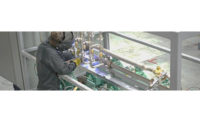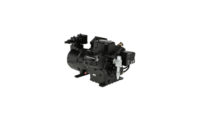Refrigeration plant optimization—freeze for less with no CAPEX
Since plants are designed to meet load on the hottest and most humid days, they have significant spare capacity most of the year.

When an industrial refrigeration plant is designed for manufacturing, its energy costs can be a distant second to other specifications. If product cools fast enough in production or stays frozen in the freezer even on the hottest and most humid day, then a plant is considered well designed.
But, can the same result be achieved with a lower energy cost?
Refrigeration plants are typically one of the biggest electricity consumers at food manufacturing plants. They’re also the most complex systems that can meet the same cooling load while working under different settings and operational procedures.
Refrigeration uses electricity to run thermodynamic processes that involve air, water and refrigerant; balancing these processes to achieve highest energy efficiency is far from trivial. Since plants are designed to meet load on the hottest and most humid days, they have significant spare capacity most of the year. During colder periods, it's possible to run refrigeration plants in very different modes and receive the same amount of cooling. In a way, operating an industrial refrigeration plant is not unlike driving a car—one can get from Point A to Point B using very different amounts of gasoline.
Energy cost reduction opportunities
One of our clients--a food processor in Canada--runs 200 hp and 100 hp fixed-speed compressors in an ammonia refrigeration system to support production load, freezer and cooler.
During an energy audit, we identified several opportunities to reduce energy consumption through change of setpoints and operational procedures as well through installation of variable frequency drives (VFDs) on condenser fans.
Production stability comes before energy efficiency
To ensure that no surprises disrupt production process at the plant, we performed all changes gradually and with full support and awareness of the operational staff. At every step of the project, the maintenance team knew what was happening, what to monitor, what to expect and how to reverse changes if things turn sour.
This work would not be possible without full support by the maintenance manager and his direct involvement.
What optimization was done and what are the savings
Within two months, we implemented all previously identified measures, found more opportunities and implemented them too. The list of implemented changes include change of setpoints, improved compressor sequencing, change of operational procedures and integration of VFDs for control of condenser fans. Prior to optimization, the client installed VFDs on evaporator fans based on our audit.
In turn, we estimated mean value of annual savings at 400,000 kWh.
Why is this not an exact number? In projects where consumption depends on production level and weather, it is not possible to determine exact savings that result from implemented changes. Day-to-day or week-to-week comparisons are not apples to apples. Resulting savings can only be estimated through various methods. The most reliable estimate can be achieved through application of the best practices, which in this area are international performance measurement and verification protocols (IPMVP).
Since accuracy of estimate was important, we followed recommendations of IPMVP—directly measured electricity consumption by all components of refrigeration plant before and after implementation for two weeks, created consumption baseline normalized to production and weather before and after and compared forecasts produced by these two baselines.
This method resulted in an estimate of 700,000 kWh per year.
Since a significant part of the savings is expected during colder months of the year, we excluded savings through the June-September period and arrived at a number close to 400,000 kWh, which is an aggressively conservative estimate.
Savings are visible
When we started work in February, the plant routinely ran two compressors during production. In July, two months after optimization was completed, the maintenance manager shared that with a similar production load, they just started using the second compressor. This means that until mid-June, one compressor fully met their production load. In fact, on colder days in March, they ran production on the smaller compressor alone.
Savings equate results of one week of plant operation
Nearly 400,000 of consumption reduction saved this client about $50,000. To earn the same amount in profit, this plant must sell, produce and ship about $1 million worth of product, which takes over a week of work. Effectively, as result of this project, the plant can go on vacation between Christmas and New Year and still experience the same profit.
Unforeseen benefits of optimization
Focussed attention on different elements of the refrigeration plant produced valuable non-energy results.
- Better control of evaporator fans through newly installed VFDs helped eliminate water condensation in the cooler, thus reducing product waste during shipment caused by wet boxes.
- When condenser fans came under control of one VFD set, identical fan motors drew vastly different amounts of power. Further investigation revealed that blades of two out of three propellers were broken.
- Diligent comparison of results produced by different pressure gauges uncovered that one of them was out of calibration, causing excessive work of condenser fans.
Lessons learned
These optimization technics helped keep operational staff comfortable about the plant’s ability to meet cooling and freezing loads. Close cooperation with the client’s staff is crucial to project progress and success. Regular communication, clear protocols and safety net procedures are important elements for a complex project.
By the same reason, it’s crucial to educate mechanical and electrical contractors about project steps and regularly monitor results of their work. Both contractors gravitated toward traditional, less energy efficient operational procedures.
Continuous monitoring of consumption by all elements of refrigeration plant makes the conversation about performance much easier—one measurement is worth a thousand of opinions and forecasts.
Optimization takes double the time expected, when machines are not new.
Looking for a reprint of this article?
From high-res PDFs to custom plaques, order your copy today!






